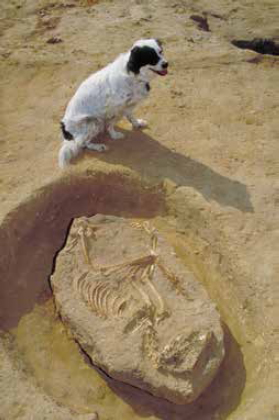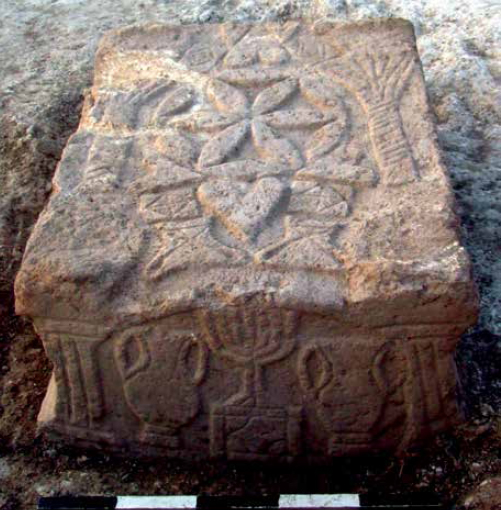
British Library Manuscript Number 17,202: A Lost Gospel? Photo credit: Associated Producers Ltd.

British Library Manuscript Number 17,202: A Lost Gospel? Photo credit: Associated Producers Ltd.

Barrie Wilson with curator from British Library and multispectral imaging experts “x-raying” the ancient text. Photo credit: Associated Producers Ltd.

Cover letter on the Syriac edition. One can plainly see a straight cut censoring the text, where the translator was going to supply the “hidden meaning.” Photo credit: Associated Producers Ltd., multispectral image by Michael B. Toth and Bill Christens-Barry.

Simcha and Barrie in front of the statue of the goddess Artemis, with tower on her head, in Ephesus, Turkey. Photo credit: Associated Producers Ltd.

Notice the bees (collar) on Artemis’ queen cells, formerly thought of as breasts. Roman age statue exhibited in the Viterbo Cathedral in Lazio, Italy. Photo credit: trotalo/Shutterstock.

Bees tending to queen cells. Photo credit: Eric Tourneret.

Ruins of the Temple of Artemis at Ephesus. Formerly one of the Seven Wonders of the World. Photo credit: Sailko, Creative Commons Attribution–Share Alike 3.0 Unported license.

Beit Alpha “synagogue,” complete with solar zodiac and image of god Helios riding his chariot (6th century C.E.). Photo credit: Associated Producers Ltd.

Simcha inspecting image of Helios in the center of zodiac at Hamat Tiberius, Galilee (4th century C.E.). Photo credit: Associated Producers Ltd.

Earliest Christian image in Rome (late 3rd to early 4th century C.E.): Jesus depicted as Helios. Julii family tomb, Vatican. Photo credit: Simcha Jacobovici.

Electron-microscope image of 3,000-year-old intact bee from Tel Rehov, Israel. Photo credit: Dr. Vitaly Gutkin.

2,500-year old-dog burials related to Artemis/Asherah worship in Ashkelon, Israel. Photo credit: Richard T. Nowitz/ CORBIS.

Unusual “altar” found in a 1st-century “synagogue,” at the edge of the ancient city of Magdala. Photo credit: Israel Antiquitie/Chameleons Eye/Newscom.

Arian Christian baptistry, late 5th century C.E., Ravenna, Italy. Jesus in central panel surrounded by the twelve apostles. Photo credit: Baptistry of Ariani, Ravenna, Italy/Giraudon/Bridgeman Images.

Galilean mosaic, 6th century C.E. church of “Our Lady Mary,” with Jesus as Helios and Mary the Magdalene as Artemis in the central panel. They are surrounded by the twelve apostles. Photo credit: Associated Producers Ltd.

“Mr. and Mrs. Jesus” in the central panel in the church of “Our Lady Mary,” Galilee, Israel. Photo credit: Associated Producers Ltd.

18th century C.E., Dekoulou monastery, Mani Peninsula, Greece. Here Jesus is alone in the central panel. The apostles have been replaced by the signs of the zodiac. Photo credit: Hercules Milas/Alamy.

Jesus’ father? Simcha inspecting Pantera’s 1st-century C.E. tombstone, Bad Kreuznach Museum, Germany. Inscription on tombstone reads: “Tiberius Iulius Abdes Pantera from Sidon, aged 62 years. Served 40 years. Standard bearer of the first cohort of archers lies here.” Photo credit: Associated Producers Ltd.

Germanicus, son of Tiberius (15 B.C.E.–19 C.E.). Is he the Roman code-named “Pharaoh’s son” in our lost gospel? Photo credit: Alun Salt, Creative Commons Attribution–Share Alike 2.0 Generic license.

Emperor Tiberius (reigned 14–37 C.E.). Is he the ruler code-named “Pharaoh” in our lost gospel? Photo credit: Public Domain, Wikimedia Commons.

1st-century C.E. image of Tiberius with Lucius Aelius Seianus’ (Sejanus) name rubbed out (“damnatio”) after his downfall. Did his demise precipitate Jesus’ crucifixion? Photo credit: Classical Numismatic Group, Inc., http://www.cngcoins.com.

Sperlonga, Italy, site of Emperor Tiberius’ palace. Sejanus rose to power after he saved Tiberius’ life in 26 C.E. at this very spot. Was Sejanus Jesus’ sponsor? Photo credit: Associated Producers Ltd.

Ivory depiction of “Woman at the Window,” 9th-8th century B.C.E. Was Mary the Magdalene such a Phoenician/Canaanite priestess? Photo credit: The Trustees of the British Museum/Art Resource, NY.

Did Mary the “tower lady,” i.e. the Magdalene, live in such a temple tower? Simcha with Jonathan N. Tubb, Middle East Keeper, The British Museum. Photo credit: Associated Producers Ltd.

“Jesus entering Jerusalem” (17th century C.E.) by Peter Paul Rubens. The palm fronds are associated with the Jewish holiday of Tabernacles, not Passover. Photo credit: Erich Lessing/Art Resource, NY.

Noli me tangere (“Touch me not”). As in Joseph and Aseneth, here Jesus pushes Mary the Magdalene away (John 20:17), his hand almost touching between her breasts. Painting by Franco Battista (16th century C.E.). Photo credit: The Dayton Art Institute, Dayton, Ohio, USA/Museum purchase with funds provided by Mr. Robert Badenhop/Bridgeman Images.

7th century C.E. Coptic papyrus. Here Jesus explicitly refers to someone—most probably Mary the Magdalene- as his “wife.” Photo credit: SIPA USA/Karen L. King/Harvard via Sipa/Newscom.